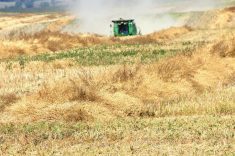British Columbia rancher Paul Devick counts himself fortunate. He sold a liner load of good quality cull cows for 11 cents a pound.
“We thought we were lucky to get rid of them,” said Devick of Heffley Creek, B.C., who sold more than 40 cows to a nearby abattoir recently.
What to do with the growing number of cull cows more than 30 months old has become a serious issue for Canadian packing plants, auction markets and cattle producers.
“The cull cow today is a liability, not an asset,” said Lee Nilsson, who owns a network of background cattle, feedlots, auction markets and packing plants across Western Canada.
Read Also

Alberta researcher helps unlock the economics of farming
Lethbridge Polytechnic researcher helping agriculture producers with decision-making tools in economic feasibility
Nilsson said he has almost daily discussions with politicians and livestock officials about what to do with the “massive oversupply” of cull cows in Canada.
“You might as well have llamas,” said Nilsson, who added he has thought of little else other than cull cows since the border closed to all Canadian cattle May 20.
When the United States and Mexico announced Aug. 8 they were opening their borders to boneless meat from animals younger than 30 months, cattle producers across the country breathed a collective sigh of relief. After 11 weeks of total border closure, some beef could now flow out of Canada.
Left unsaid was what to do with the hundreds of thousands of Canadian cull cows that are slaughtered each year in Canada or the U.S.
“We have a major problem here in Western Canada with our cull cows and bulls,” said Gordon Scarlett, a Sexsmith, Alta., feedlot operator. Until the border closed, he had specialized in buying cull cattle from the auction markets, fattening them and reselling them to American packing plants.
Since the border closed, he has not bought a single animal.
Traditionally each fall cattle producers take a close look at their herds and ship cows and bulls that they feel are too old, too mean, too crippled or will no longer produce good calves.
In 2002, 497,002 cows and 9,843 bulls were slaughtered in Canada. An additional 305,588 cows and bulls were exported to the U.S. for slaughter, up 33 percent from the year before.
Before the border closed, Nilsson’s XL Beef plant in Moose Jaw, Sask., slaughtered 800 cows a day. About 40 percent of that plant’s production was exported to the U.S. The plant is now killing about 400 head a day.
No market
Even at capacity there is no market for the meat from cull cows, said Nilsson. With fat cattle selling for rock bottom prices, consumers would rather buy meat from a young steer or heifer.
Nilsson said there have been discussions within government and industry about building a slaughter plant dedicated to killing cows. Even if construction started immediately, it wouldn’t be operating for at least a year and export rules can change a lot during that time.














